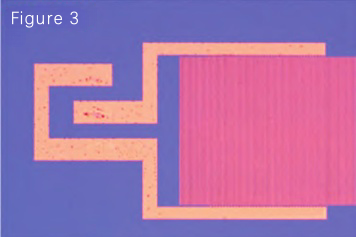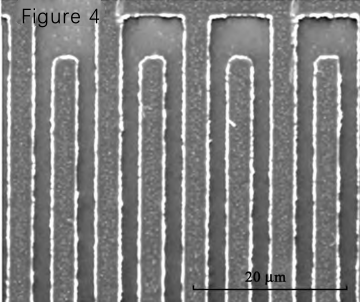3 The main application of lithium tantalate crystal
3.1 SAW Wave filter
Yang Qing-rui and others designed a resonator SAW filter using LiTaO3/SiO2/Si substrate. Figures 3 and 4 are optical photos of the device and partial scanning electron microscopy pictures of the device respectively. The interdigitated electrodes of the device in the picture are clear and no adhesion is seen. They will be analyzed and optimized later.
It can be seen that increasing the number of electrode pairs or electrode aperture of the resonator can improve the performance coefficient of the device itself, and the number of electrode pairs has a greater impact on performance. In a resonator with the same static capacitance, the lower value of the ratio of electrode aperture to the number of electrode pairs, the higher the performance coefficient of the device. The electromechanical coupling coefficient first increases and then decreases as the electrode period increases.
Kimura T et al. studied the applicability of an acoustic wave device using an interdigital transducer placed on a thin piezoelectric crystal plate at 3 to 5 GHz, in which the performance of the SAW device dropped significantly. This proves that the quality factor Q of the composite structural layer using LiTaO3/SiO2/Si is 3 to 4 times higher than that of the 42°Y-X LiTaO3 (42-LT) bulk material. Three types of sawtooth devices were fabricated using a KrF stepper/scanner, and their performance was compared in all aspects: a 3.5GHz resonator connected to a Si substrate using a rotating V-cut LiTaO3 board; 5GHz resonator using X-cut-LiNbO3 board; independent 5.4GHz A1-Lamb mode resonator on Z-cut-LiNbO3 (www.wisoptic.com) board. The results show that these devices also have excellent performance at 3~5GHz. Fu Chen and others used ANSYS software to conduct finite element analysis of 36° YX-LiTaO3 (www.wisoptic.com) material, and designed a general and effective method for analyzing leaky wave resonators. Kadota Michio et al. designed a SAW resonator using horizontal shear waves (SH) confined in a thin lithium tantalate layer supported by a quartz (Qz) substrate. The measured impedance ratio reached 84dB. On the other hand, due to the unique nature of quartz, stray waves other than SHSAW are not confined in the LT layer, resulting in spur-free characteristics across a wide frequency range. Yan Xiong shuo et al. used focused ion beam (FIB) technology to prepare a high quality factor based on LT-on-Insulator (LTOI) film LT resonator. The LTOI microdisk achieved a second harmonic output power of 2μW at an input power of 500mW. At the same time, the generation of cascaded third harmonics was also observed in the device.
Post time: Dec-12-2023


